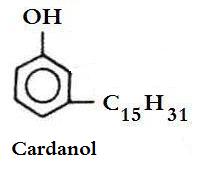
| |
| Home |
| All things Cashew |
| What is CNSL? |
| Cardanol |
| Anacardic Acid |
| Cashew Shell Cake |
| Contact Us |
| CARDANOL |
|
Cardanol is a naturally occurring Phenol manufactured from CNSL (Cashew Nut Shell Liquid). It is a monohydroxyl Phenol having a long hydrocarbon Chain (C15H27) in the meta position.
The products obtained from Cardanol have many advantages over these manufactured from other substituted Phenols. It is therefore widely used in the manufacture of surface coatings, Insulating Varnishes, Oil and Alcohol soluble resins, Laminating resins, Rubber compounding, Azo dyes, etc.
The components of commercial Cardanol differs in the degree of unsaturation Of the side chain but for the practical purposes it can be represented by the following formula.
C6H4(OH)-(CH2)7-CH=CH-CH2-CH=CH(CH2)2 -CH3
The average unsaturation of about two double bonds in the side chain of the Cardanol molecules make cross linking easy and give a satisfactory gradual drying and baking properties to paints prepared from it. Because of its peculiar structure Cardanol Varnishes have high electric Insulation, greater resistance to water chemicals and good flexibility. The long hydrocarbon side chain imparts to Cardanol aldehyde condensate greater solubility in drying Oils such as linseed DCO, or tung Oil and aliphatic hydrocarbons.
Cardanol can be substituted by 30% in phenolic resins used for phenol bonded resins for plywood and lamination industries.
Water soluble PCF resin (phenol, Cardanol pharmaldehyde resin): We develop PCF resin by substituting 30% Cardanol in phenolic resins. The resins will give additional property of antifungus and antithermic when used in plywood industries. In lamination industries it gives additional advantage in non-edge cracking and also cost saving.
Cardanol Extraction Process
It is known that CNSL mostly contains two important constituents Anacardic acid -an acidic substance; and Cardol - a non-acidic material. The main objectives of extraction of Cardanol from CNSL are to provide a simple and economical method for isolating the so called Cardol complex from Anacardic acid,
-
to provide an improved method of extraction of the decarboxylated product 'Anacardol' or otherwise known as 'Cardanol' from cashew nut shell liquid,
-
to provide a method of forming and extracting cardanol from CNSL by direct treatment of the oil and not by the indirect route of separation of anacardic acid and then treating the same,
-
to provide a simple laboratory apparatus for the extraction of the above materials, Which may ultimately be practiced on a commercial scale and
-
to indicate the commercial application of anacardol.
According to the invention CNSL is subjected to fractional distillation at 200° to 240°C under reduced pressure not exceeding 5mm. mercury in the shortest possible time which gives a distillate containing Cardol and the residual tarry matter, for example, in the case of a small quantity of oil, say 200 ml/ the distillation period is about 10 to 15 minutes. A semi-commercial or commercial scale distillation of CNSL may however take longer times. It has been found that there are certain difficulties of operation with regard to single-stage fractional distillation method, i.e. frothing of the oil which renders difficult the fractionation of Cardol and also formation of polymerized resin. These difficulties can be over come in the two-stage distillation, if care is taken not to prolong the heating; this is to avoid the undue formation of polymerized resins and possible destruction partially or completely of the Cardol or anacardol. When CNSL is distilled at a reduced pressure of about 2 to 2.5 mm. mercury, the distillate containing anacardol and cardol distils firstly at about 200°C to 240°C. This first distillate is then subjected to a second distillation under the same identical conditions of temperature and pressure when the anacardol distils over at a temperature of 205°C to 210°C and the cardol distils over at a temperature of 230°C to 235°C. In practice it has been found that the preliminary decarboxylation of the oil is essential, since there will be excessive frothing, which renders the distillation procedure unproductive and uneconomical. A specific feature of this invention is that both cardol and anacardol may be obtained by a three-step process. The first step of the process is to get the decarboxylated oil by heating the oil to a temperature of 170°C to 175°C under reduced pressure of 30-40 mm. mercury. The next two steps are the same as above for the production of both cardol and anacardol. This invention is significant in the sense that it can be applied not only to the cashew nut oil but also to cashew nuts themselves or nut shells.
Cardanol Specification
| PARTICULARS | GRADE-1 |
SPECIAL GRADE |
|---|---|---|
| Structural Formula | OH C6H4C15H27 |
OH C6H4C15H27 |
| Density | 0.9272-0.9350 |
0.9272-0.9350 |
| Viscosity at 30°C | 55.65(CP) |
55.65(CP) |
| Melting point (Less than) | 50°C |
50°C |
| Volatiles Maximum as per IS 101-1964 | 1% |
1% |
| Ash Contents | Negligible |
Negligible |
| Iodine Value IS 548-1964 (Catalytic Method) | Min 250 |
Min 275 |
| Acid Value | Max 5 |
Max 5 |
| Hydroxyl Value | 180-190 |
180-190 |
| Colour Gardener (Freshly Distilled) | Light Brown |
Pale Straw |
| Moisture | 1% V/V |
1% V/V |
|
Structure of Cardanol Structure of Cardanol |

